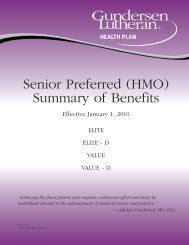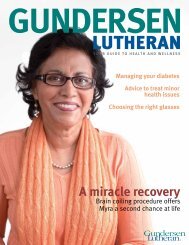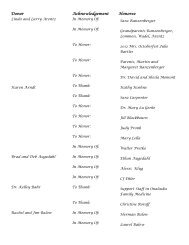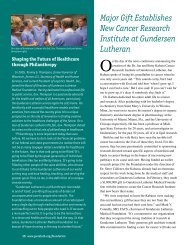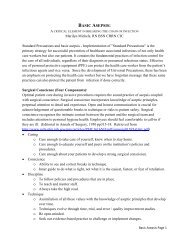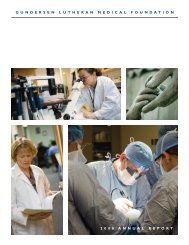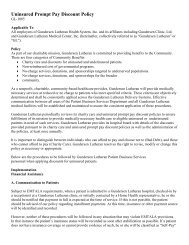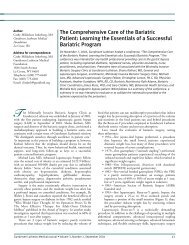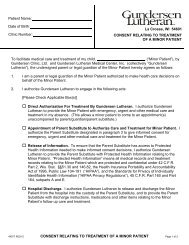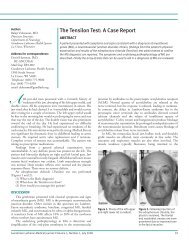Streptococcus bovis - Gundersen Lutheran Health System
Streptococcus bovis - Gundersen Lutheran Health System
Streptococcus bovis - Gundersen Lutheran Health System
You also want an ePaper? Increase the reach of your titles
YUMPU automatically turns print PDFs into web optimized ePapers that Google loves.
Authors:<br />
Robert E. Ryan, MA, ATC<br />
Troy E. Ward, MA, ATC<br />
Steven R. Murray, DA<br />
Mesa State College<br />
Grand Junction, Colorado<br />
Mitchell T. Copeland, DO<br />
Western Orthopedics and<br />
Sports Medicine<br />
Grand Junction, Colorado<br />
Brian E. Udermann, PhD, ATC,<br />
FACSM<br />
University of Wisconsin–La Crossse<br />
La Crosse, Wisconsin<br />
Robert W. Pettitt, PhD, ATC<br />
Minnesota State University –Mankato<br />
Mankato, Minnesota<br />
Address for correspondence:<br />
Brian E. Udermann, PhD, ATC,<br />
FACSM<br />
149 Mitchell Hall<br />
1725 State Street<br />
University of Wisconsin–La Crossse<br />
La Crosse, WI 54601<br />
Telephone: (608) 785-8181<br />
email: udermann.bria@uwlax.edu<br />
I<br />
n a d 175, the ancient Greek physician Galen used a<br />
resorbable gut suture—the first recorded use of a<br />
bioabsorbable implant. 1 In the mid 1960s, bioabsorbable<br />
technology was introduced for clinical applications, since which<br />
time its use has increased dramatically. 2 Today some 40 different<br />
bioabsorbable polymers are being used for surgical procedures. 1,3<br />
Advantages have been noted for the use of bioabsorbable<br />
implants in orthopedics. First, they are readily absorbed by the<br />
body, thus reducing the need for surgical revisions and the overall<br />
cost of treatment. 4 Second, they prevent radiographic obscurities<br />
typically found with metallic implants. 4 Third, in that they soften<br />
over time, bioabsorbable implants provide an incremental transfer<br />
of stress to the affected bone, thus providing a load-sharing effect<br />
that enhances healing. 1<br />
While they have notable advantages, bioabsorbable implants<br />
have drawbacks, as well. Compared with their metallic counterparts,<br />
bioabsorbable implants are weaker and less stiff, have limited shelflife,<br />
and are initially more costly. 1 They also can cause exaggerated<br />
inflammatory reactions, such as synovitis, osteolysis, and, more<br />
rarely, giant-cell reactions. 5,6<br />
We report a case of a foreign-body giant-cell reaction to<br />
a bioabsorbable implant. This case exemplifies an iatrogenic<br />
etiology that should be considered when treating patients who are<br />
unresponsive to rehabilitative exercise for surgical repair.<br />
Giant-Cell Reaction to a Bioabsorbable Implant<br />
AbStrACt<br />
A 51-year-old woman had shoulder pain and dysfunction 14 months following the surgical<br />
repair of her supraspinatus muscle via a bioabsorbable implant. Diagnostic testing revealed<br />
a giant-cell reaction at the location of the implant. The patient underwent a second surgery<br />
to burr, irrigate, and fill the lytic lesion that resulted from the giant-cell reaction, and the<br />
supraspinatus muscle was sutured to the greater tuberosity of the humerus. The patient<br />
completed a standard rehabilitation protocol for 8 weeks, and at 6 months she had no further<br />
complications with normal daily activities.<br />
CASe report<br />
A 51-year-old woman had pain in her right shoulder.<br />
Examination of the shoulder revealed an impingement syndrome,<br />
acromioclavicular arthrosis, and a tear in the supraspinatus<br />
muscle. Initial conservative treatment with range-of-motion and<br />
strengthening exercises and subacromial injections of steroids<br />
(ie, 3 mg of betamethasone and 6 mg of 0.25% bupivicaine) was<br />
ineffective. The patient was counseled and scheduled for surgery.<br />
Surgery included a 2-step acromioplasty and an 8-mm resection<br />
of the distal clavicle. The supraspinatus muscle was repaired using<br />
a bioabsorbable implant (Arthrex Bio-Corkscrew), with 4 sutures<br />
placed in a figure-of-8 fashion through the greater tuberosity of<br />
the of the humerus. The patient progressed without complications<br />
for 12 weeks until marked pain returned to the shoulder area.<br />
Conservative treatment, including modest range-of-motion and<br />
strengthening exercises, ensued resulting in a return to normal<br />
daily activities, Fourteen months after surgery, a palpable lesion<br />
deficit was found in the area of the of the implant. Radiographs<br />
revealed a 4- to 6-mm circular lytic lesion consistent with the<br />
site of placement of the bioabsorbable implant in the greater<br />
tuberosity (Figure 1). Given the findings and the patient’s course<br />
postoperatively, she was scheduled for shoulder arthroscopy with<br />
possible supraspinatus muscle repair and placement of a bone graft<br />
in the area of erosion.<br />
<strong>Gundersen</strong> <strong>Lutheran</strong> Medical Journal • Volume 6, Number 1, June 2009 21




